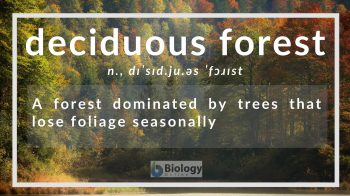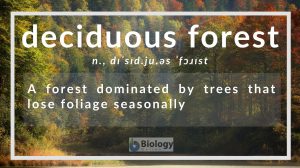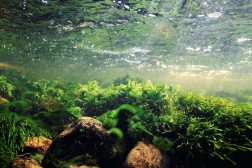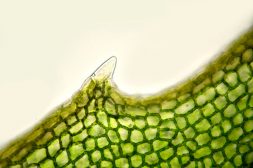
deciduous forest
n., dɪˈsɪd.ju.əs ˈfɔɹɪst
A forest dominated by trees that lose foliage seasonally
Table of Contents
Deciduous Forest Definition
A deciduous forest is a type of forest dominated by trees that lose their foliage at the end of the growing season. This is in contrast to an evergreen forest where a majority of the trees remain “green” throughout the year because they shed leaves not seasonally but at various periods of the year. In a deciduous forest, there is a complete seasonal loss of leaves followed by the production of new foliage. The term deciduous means “temporary” or “tending to fall off” (from the Latin dēciduus, meaning “falling off”).
Leaf Fall
Why do deciduous trees shed their leaves seasonally? Deciduous trees are shedding leaves as a mechanism against the cold season (winter) in temperate regions or to the hot dry season of the subtropical and tropical regions. Evergreens do not need to lose their foliage because they have other mechanisms to protect them (e.g. anti-freeze chemicals in the cells and a wax coat on leaves). Deciduous trees, in contrast, have no such adaptations. Their tissues are tender and susceptible, particularly to the adverse effects of freezing. (Ref. 1)
With the help of light receptors such as phytochromes and cryptochromes, the deciduous plant detects day-length changes and as such can respond physiologically. The plant takes the nutrients from the leaves back to the stems and the roots. It breaks down the chlorophylls (green pigments) on its leaves, leaving the non-green pigments (e.g. carotenoids). It may also produce another pigment group, the anthocyanins. (Ref. 1) The presence of carotenoids and anthocyanins accounts for the leaves shifting colors. Leaves high in carotenoids will turn their color into brilliant gold or yellow whereas those high in anthocyanins shift into red, purple, or brown. (Ref. 1) The plant subsequently severs the tissues supporting the leaves. Consequently, the leaves will fall or be blown off by the wind. When this happens, the cut will be sealed, leaving a leaf scar. When the winter or the dry season is over, the plant regrows its leaves enriched with chlorophylls again so as to efficiently capture light for photosynthesis.
Types of Deciduous Forests
Based on the geographical location, deciduous forests may be temperate, subtropical, or tropical. Temperate deciduous forests are found in eastern North America, western Eurasia, and northeastern Asia. (Ref. 2) Subtropical deciduous forests are located in the subtropical regions whereas the tropical deciduous forests, in the tropics.
Deciduous trees of the temperate forest will lose their leaves in autumn and then regrow them in spring. As for the deciduous trees of the tropical and subtropical forests, they will lose their foliage in the dry season and then regrow their leaves in the rainy season. Thus, the leaf drop in the temperate deciduous forest is a response to the seasonal temperature variations whereas the leaf drop in tropical and subtropical deciduous forests is a response to the seasonal rainfall patterns.
Zones of Deciduous Forests
In essence, there are five zones of a deciduous forest: (Ref. 3)
- Tree stratum zone – the first zone consisting of tall trees, with a height ranging from 18 m to 30 m.
- Small tree and sapling zone – the second zone consisting of younger trees with heights that are relatively shorter than those of the trees in the first zone.
- Shrub zone – the third zone consisting of shrubs (e.g. huckleberries and mountain laurel).
- Herb zone – the fourth zone where herbal plants thrive (e.g. ferns).
- Ground zone – the fifth zone where lichens and mosses grow on the ground.
Dominant Trees
In the mid-latitude deciduous forests, the dominant trees are oaks, beeches, birches, chestnuts, aspens, elms, maples, and basswoods. (Ref. 2) In the Southern Hemisphere, the dominant tree is the genus Nothofagus (southern beeches).
Animal Inhabitants
Common invertebrates of deciduous forests are snails, slugs, insects, and spiders. As for vertebrates, the animals commonly found are snakes, frogs, salamanders, turtles, birds, and mammals. Examples of birds commonly found in deciduous forests are warblers, owls, thrushes, vireos, woodpeckers, and hawks. Examples of mammals commonly inhabiting this type of forest are mice, moles, chipmunks, rabbits, weasels, foxes, and deer. (Ref. 2)
See Also
References
- Why Leaves Fall from Trees in Autumn • The National Wildlife Federation Blog. (2014, September 5). The National Wildlife Federation Blog. https://blog.nwf.org/2014/09/why-leaves-fall-from-trees-in-autumn/
- deciduous forest | Definition, Climate, & Characteristics | Britannica. (2020). In Encyclopædia Britannica. https://www.britannica.com/science/deciduous-forest
- KDE Santa Barbara. (2020). Ucsb.Edu. http://kids.nceas.ucsb.edu/biomes/temperateforest.html
©BiologyOnline. Content provided and moderated by BiologyOnline Editors.







